Long before dawn on a chilly April morning, with just enough grainy light to see by, my friend Adrian Webber and I found ourselves where we so often did in those days: prowling the serpentine banks of Riebolt’s Creek in northern Door County—a.k.a. Wisconsin’s “thumb”—fishing for steelhead. We’d determined that the lower the light, the better the bite; we’d also determined that other anglers were clued into this as well, including a factory worker from downstate who not only hoarded his vacation to fish the Door County steelhead run, but slept in the back seat of his car, a hulking old gas-guzzler that might have been a Chrysler, in order to save time and be the first fisherman on the stream.
We knew this because we found him there one morning when he’d overslept. He was parked at the end of a vague two-track that led to a piece of state ground, out of sight of any eyes that might have taken a dim view of what was illegal overnight camping, technically.
On the morning I’m talking about, we beat the downstate guy, and everyone else, to our favorite spot—the last hundred yards or so of the creek, before it spills into Moonlight Bay and Lake Michigan. This required an especially heroic effort on Adrian’s part, who had a half-hour drive just to get to my place, then another 15 minutes to get to Riebolt’s. We liked to be there no later than 5 a.m., which meant he had to be on the road by 4:15.
Ouch is right.
Of course this brutal schedule wouldn’t have been in the cards for either of us were it not for the fact that we were both a bit, um, “underemployed” back then. Adrian was doing a spot of subbing while working, somewhat fitfully, toward earning his teaching certification; I was trying, in a sort of half-assed way, to write about the outdoors and get paid for it. Our wives had full-time jobs and at the time were still pretty tolerant of our lifestyle although this would change, sooner in my case than in Adrian’s. A Brit from Seascale, Cumbria, on England’s northwest coast, he’d only been in the States for a couple of years at that point. What brought him here? A woman, of course. And yes, it was the same woman he eventually married.
More Like This
At any rate, if the bad news was that we barely had two nickels to rub together, the good news is that we had no place else we needed to be and therefore had plenty of time to fish for steelhead, also to dip-net smelt, hunt for mushrooms, asparagus, and other wild edibles, etc.
One of those “etceteras” was drinking beer in the middle of the afternoon at a dumpy roadhouse called the AC Tap. The price was right: 35 cents for a glass of whatever came out of the spigot. Even a couple of broke guys like us could swing that.
I can’t recall for certain whether either of us caught a steelhead that morning. Our obsessive avidity notwithstanding, we weren’t especially successful. Simply hooking one felt like a triumph; on the cosmically rare occasions we actually landed one our cheap chest waders were in danger of splitting at the seams.
What I do recall is this: After we’d been fishing for a while and the details of the landscape had begun to emerge, something started to fall, silent and almost hypnotically dreamlike, from the gray, featureless sky. I didn’t notice it, at first. But then Adrian, who was on the opposite side of the creek, looked up at the soft white particles drifting down.
“What’s this?” he asked, his face a mask of childlike wonder. “Volcanic ash?”
He was dead-serious (later it occurred to me that this might have reflected the ocean-moderated climate he’d grown up in), and for reasons I can’t explain the idea that volcanic ash could be falling from the sky in Door County, Wisconsin, didn’t strike me as laughable. Not at that moment, anyway. I guess I was so focused on fishing, and on staying hyper-alert for the almost imperceptibly light tug that can mean a steelhead’s taken the bait, that my mind wasn’t prepared to field the question. I had to blink a few times, and give my head a second or two to clear, before I could articulate a response.
“Adrian,” I said. “It’s snow.”
Oh, and because you’re wondering, I mean “bait” literally: spawn sacs made from fresh salmon eggs wrapped in pieces of bright orange mesh. We’d sort of thread them onto about a #6 hook, crimp a split shot on the line a foot or so above it, then lob the whole works into the current with light spinning gear. I’d read that it was possible to catch steelhead on flies (and would have liked to do it that way), but the plain fact of the matter is that in those days my skills weren’t up to the task—especially when you layered the brushily tight confines of those Door County creeks on top of the inherent challenge of inducing a steelhead to eat a fly.
Still, every so often I’d rig up my fly rod, a 9-weight Fenwick “Fenglas” with that distinctive milky-red finish, and give it the old college try. On one such morning when I was fishing Riebolt’s by myself—my recollection is that Adrian had come down with pneumonia, no doubt brought on by the punishing hours we kept—I noticed, out of the corner of my eye, a log floating toward me in the middle of the stream. I turned my head ever so slightly…and the log resolved into a pretty good-sized beaver.
He didn’t appear to know that I was there—the light was poor, and I was drably dressed—and while I watched he unhurriedly angled to the bank a few yards upstream from where I was standing. There he clambered ashore and, dragging his paddle of a tail behind him, proceeded to cross the county highway enroute to Moonlight Bay and wherever his final destination may have been.
That’s not something you see every day.
A few minutes later I flipped my fly—a Skunk, I think it was—toward the far bank and fancied I saw a flash. I stripped it in, tossed it back in more-or-less the same place, and immediately came tight to a fish.
Whatever this fish was, though, it wasn’t big enough to put much of a bend in that beast of a rod. After what felt less like a fight than a mild protest it lay at my feet. It was about a 12-incher, silvery overall with a few pale spots, and while clearly a salmonid it took me a while to make a positive ID: a lake-run brookie.
In other words, breakfast! Gutted, gilled, lightly floured and sautéed in butter, with a couple of scrambled eggs and a side of sliced potatoes also browned in butter, it was fit for a king. Because no one was looking, I even poured myself a glass of Chablis. It just seemed like the right thing to do.
Oh yeah, baby: Back in my steelheading days, I walked on the wild side.





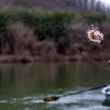





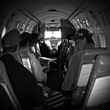
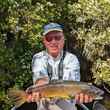


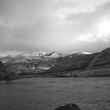





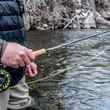



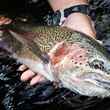
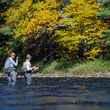

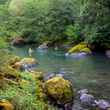
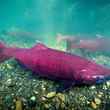
Comments